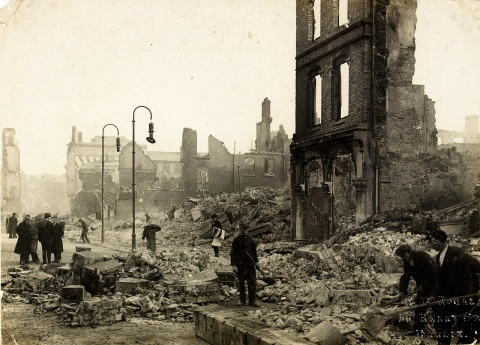Centenary of the burning of Cork by Black and Tans and British armed forces

Immediately after the Armistice with Germany which ended the First World War in 1918, a General Election was called in the United Kingdom. On 14 November it was announced that Parliament would dissolve on 25 November, with elections on 14 December. The Irish General Election of 1918 was that part of the 1918 general election which took place in Ireland. In 1918 the whole of Ireland was a part of the United Kingdom of Great Britain and Ireland, and was represented in the British Parliament by 105 MPs. It was a significant moment in modern Irish history. Since the 1880's the moderate nationalist Irish Parliamentary Party (IPP), had dominated the Irish political landscape. That was to all change in 1918. The result in Ireland was a landslide victory for the Irish republican party Sinn Féin whose candidates won 73 seats out of 105.
In the aftermath of the elections, Sinn Féin's elected members refused to attend the British Parliament, instead they formed a parliament in Dublin, the First Dáil (Irish for "Assembly"), which declared Irish independence as a republic. The Dáil reaffirmed the 1916 Proclamation with the Irish Declaration of Independence. The British refusal to accept the democratic vote of the Irish people was to lead to the Irish War of Independence between 1919 - 1921. A conflict during which the British government faced severe criticism at home and abroad for the brutal actions of British forces in Ireland. Not least being the behaviour of the Black and Tans and Auxiliaries.
The British government had bolstered the Royal Irish Constabulary (RIC) with recruits from Britain—the Black and Tans and Auxiliaries—who became notorious for ill-discipline and reprisal attacks on civilians. There are many incidents of these reprisal attacks on civilians and civilian property as well as extrajudicial killings, arson and looting. Some of which were authorised by the British government. One of most significant of these reprisals carried out by the British forces on Irish civilians during the war, was the burning of the city of Cork (Irish: Corcaigh) in the south-west of Ireland.
This was carried out on the night of 11–12 December 1920. The attack on the city was in retaliation for a series of IRA operations in Cork, including the Kilmichael Ambush and the Dillon's Cross Ambush. Seeking revenge, the Auxiliaries, Black and Tans and British soldiers rampaged through Cork. They looted and burnt down many of the buildings in Cork city centre. Civilians reported being fired upon, beaten and robbed by British forces. When firefighters attempted to tackle the blazes British forces had tried to prevent their attempts to tackle the blazes through intimidation, cutting their hoses and shooting at them. More than 40 business premises, 300 residential properties, the City Hall and Carnegie Library were destroyed by the fire.
The British government at first denied that its forces had started the fires, and blamed the IRA. Later, even a British Army inquiry concluded that a company of Auxiliaries were responsible. Known as the "Strickland Report", it concluded that members of the Auxiliaries' K Company, based at Victoria Barracks bore most of the responsibility for setting the fires. The British Government refused to publish the report. However, accounts from a variety of witnesses pointed out that the Auxiliaries, Black and Tans and British soldiers were involved in the looting, attacks and burning. It has long been thought that the burning of Cork was not some random act. The scale of the destruction and the means to carry it out had required a degree of planning. At that time the British government, implicitly or explicitly, were engaged in a policy of intimidation and violence against the Irish population. Many believe that the series of IRA operations in Cork prior to the night of December 11-12 1920 gave an opportunity and excuse for British forces to carry out a plan which was long premeditated and for which all arrangements had been made.
Image: St Patrick's Street in Cork following the fires.





